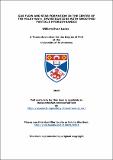Files in this item
Gas flow and star formation in the centre of the Milky Way : investigations with smoothed particle hydrodynamics
Item metadata
| dc.contributor.advisor | Bonnell, Ian Alexander | |
| dc.contributor.author | Lucas, William | |
| dc.coverage.spatial | 268 | en_US |
| dc.date.accessioned | 2015-04-30T12:17:01Z | |
| dc.date.available | 2015-04-30T12:17:01Z | |
| dc.date.issued | 2015-06-24 | |
| dc.identifier.uri | https://hdl.handle.net/10023/6601 | |
| dc.description.abstract | The centre of the Milky Way, commonly referred to as the Galactic Centre, is roughly that region within 500 pc of the central black hole, Sagittarius A*. Within the innermost parsec around the supermassive black hole Sagittarius A* are more than a hundred massive young stars whose orbits align to form one or possibly two discs. At about 100 pc is a ring containing more than ten million solar masses of molecular gas which could be the origin of some of the most massive star clusters in the Galaxy. I have performed a number of numerical simulations to help us understand how it is that these structures may have been formed. I firstly describe and test an improvement to the smoothed particle hydrodynamics code I used. This improves conservation of energy and momentum in certain situations such as in strong shocks from supernovae, which were to be included in a later chapter. The discs of massive stars around Sagittarius A* are believed to have been born there within fragmenting gaseous discs. This is problematic, as the formation of two stellar discs would require two gaseous counterparts. A method is described of forming multiple discs around a black hole from a single cloud’s infall and subsequent tidal destruction. This is due to its prolate shape providing a naturally large distribution in the direction of the angular momentum vectors within the cloud. The resulting discs may then go on to form stars. Energetically, it would appear that a sequence of supernovae could potentially cause a giant molecular cloud to fall inwards towards the central black hole from an originally large orbit around the Galactic Centre. I simulate the impact on a giant molecular cloud of supernovae originating from a massive stellar cluster located a parsec away. Ultimately, the supernovae are found to have little effect. Finally, I simulate the formation of the dense ring of clouds observed in the Central Molec- ular Zone at a distance of about 100 pc from Sgr A*. Infalling gas is shown to be subject to such extreme tidal forces that a single cloud of gas is extended to form a long stream. The ribbon grows to the point that it self-intersects and forms a ring-like structure. Its complexity depends on the orbit of the original cloud. The position-velocity data is compared with observations, and similarities are noted. | en_US |
| dc.language.iso | en | en_US |
| dc.publisher | University of St Andrews | |
| dc.relation | Lucas, WE, Bonnell, IA, Davies, MB, & Rice, WKM, 2013, MNRAS, 433, 353 (doi:10.1093/mnras/stt727) | en_US |
| dc.subject | Astronomy | en_US |
| dc.subject | Astrophysics | en_US |
| dc.subject | SPH | en_US |
| dc.subject | Galactic Centre | en_US |
| dc.subject | Star formation | en_US |
| dc.subject | Milky Way | en_US |
| dc.subject | The Galaxy | en_US |
| dc.subject.lcc | QB806.L8 | |
| dc.subject.lcsh | Stars--Formation--Mathematical models | en_US |
| dc.subject.lcsh | Galactic center | en_US |
| dc.subject.lcsh | Hydrodynamics | en_US |
| dc.title | Gas flow and star formation in the centre of the Milky Way : investigations with smoothed particle hydrodynamics | en_US |
| dc.type | Thesis | en_US |
| dc.type.qualificationlevel | Doctoral | en_US |
| dc.type.qualificationname | PhD Doctor of Philosophy | en_US |
| dc.publisher.institution | The University of St Andrews | en_US |
This item appears in the following Collection(s)
Items in the St Andrews Research Repository are protected by copyright, with all rights reserved, unless otherwise indicated.

